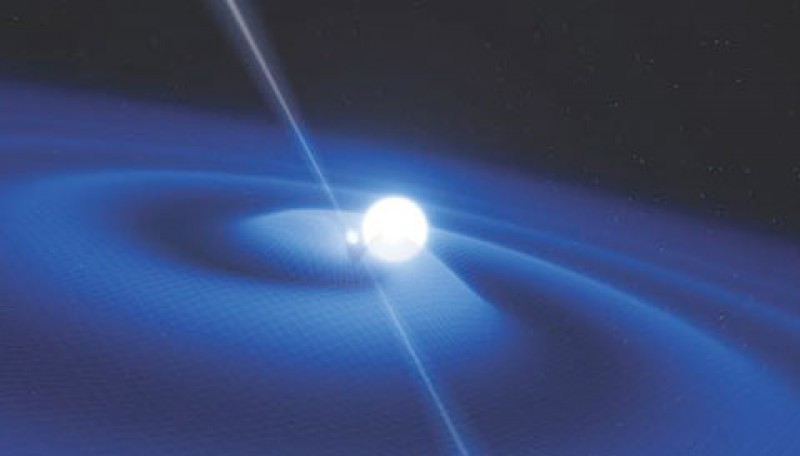
Scientists recently studied a pulsar binary system to constrain the existence of a hypothetical fifth fundamental force of nature.
We already know about four fundamental forces: gravity, electromagnetism, and the strong and weak nuclear forces. However, there are some effects in the universe that cannot be explained by these forces alone. For example, a 2016 experiment in Hungary showed unexpected behavior in the decay of nuclei in the isotype beryllium-8. (After shooting protons at lithium foil, observers saw more electron-positron pairs ejected at a 140-degree angle, which is difficult to explain with standard nuclear physics theories.)
One possibility is the existence of a "fifth force" of nature, which governs the behavior of elementary particles alongside the other four forces. Some scientists suggest this force could work on dark matter, the unseen substance that makes up most of the universe's mass. We can see dark matter’s effects on ordinary matter, but direct detection has eluded scientists and what it’s made of remains unknown.
Testing for a Fifth Force
One research group tested for a fifth force using a pulsar and its white dwarf star companion. Pulsars, whose atoms have been compacted into neutrons, are so dense that their extreme gravitational fields could enhance any possible interactions with dark matter. The white dwarf, while still sardine-packing its atoms, isn’t nearly so compact. General relativity predicts that normal matter ought to fall freely toward dark matter, but a fifth force that has the ability to interact with both normal and dark matter could strengthen or diminish dark matter’s pull. If a fifth force does exist, the Milky Way’s dark matter halo, whose density ought to peak in the galactic center, would pull on the neutron star and the white dwarf in different ways, slightly altering their orbit.
The researchers chose binary pulsar PSR J1713+0747, which is 3,800 light-years from Earth, lying in the direction of the galactic center. Dark matter is believed to be more populous towards the heart of the galaxy, so the pulsar binary system provides an ideal test how a fifth force would act on dark matter and standard matter. The researchers wanted to see if the movements of the pulsar and white dwarf would differ as they orbited one another.
"If there is a fifth force that acts between dark matter and standard matter, it would not be universal," says Lijing Shao (Max Planck Institute for Radio Astronomy, Germany). "It would therefore produce an apparent difference for the neutron star and the white dwarf in their free fall towards dark matter. Thus, the orbit of the neutron star would be different than what is predicted by the general relativity."
Using 20 years of radio observations of this system, the researchers concluded that if a fifth force does exist, it must have less than 1% of gravity’s strength . (And gravity is already the weakest of the four known forces.) The results appear in Physical Review Letters.
The researchers also discovered that the limits on the density of dark matter at this pulsar system were similar to other tests closer to Earth. In other words, the team didn't prove or disprove other observations showing that dark matter density increases towards the center of the galaxy.
Beyond Relativity
Aurélien Hees (Observatory of Paris), who was not involved in the study, noted that this work is the first to investigate interactions between a hypothetical fifth force and dark matter in this way. The short rotational period of the pulsar – just 4.6 milliseconds – and its stable rotation made it a good candidate for constraining the effects of the fifth force, he said.
With the fifth force, he explains, "We expect to see something a little bit beyond relativity. We are trying to search for that with all the observations available from Earth."
Shao says his team hopes to study more binary pulsars closer to the center of the galaxy to better understand the effects of dark matter. Unlike most tests of general relativity, in this case the researchers want to find pulsars moving in relatively slow orbits around their companion The challenge, of course, is finding the pulsars in the first place. He suggested a breakthrough will come when the more sensitive Square Kilometer Array is ready in the 2020s. "Bigger radio telescopes and arrays are better because they more precisely measure the time of the [pulsar signal] arrival," Shao said.